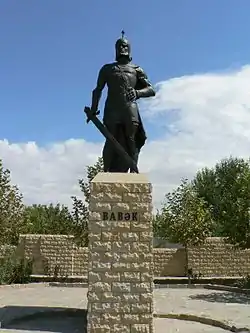Khurramites
The Khurramites (Persian: خرمدینان Khorram-Dīnân, meaning "those of the Joyful Religion") were an Iranian[1][2][3] religious and political movement with its roots in the movement founded by Mazdak.[3] An alternative name for the movement is the Muḥammira (Arabic: محمرة, "Red-Wearing Ones"; in Persian: سرخجامگان Sorkh-Jâmagân), a reference to their symbolic red dress.

Origins and history
The sect was founded in the 8th century CE by the Persian cleric Sunpadh and was a revitalization of an earlier sect that had mixed Shī‘a Islam and Zoroastrianism; however, its true claim to fame was its adoption by Bābak Khorramdin as a basis for rebelling against the Abbasid Caliphate.
The sect grew out of a response to the execution of Abu Muslim by the Abbasids, and denied that he had died, rather claiming that he would return as the Messiah. This message was further confirmed by the appearance of a prophet named al-Muqanna‘ "The Veiled", who claimed that the spirit of God had existed in Muhammad, ‘Alī and Abu Muslim.
According to al-Tabari, their name first appared in 736 when missionary Kedas of Hasemite adopted “din al-Ḵorramiya”, and after Hasemite revolution the khorramis were fought as rebels under Sonbadh, Moqanna, Babak and other different leaders in the various cities and regions.[4]
The movement of Khurramites in Azerbaijan was associated with Javidhan who was a landlord leader of one of the two Khurramite movements in Azerbaijan (from 807-808 to 816-817), with his headquarters being in Badd located close to the river Aras. The leader of the other Khurramite movement was Abu Imran, who often clashed with Javidhan′s forces. During one of the clashes, in probably 816, Abu Imran was defeated and killed, whilst Javidhan was mortally wounded, dying three days later. Javidhan was succeeded by his apprentice Babak Khorramdin, who also married Javidhan's widow.[5][6]
The story of Babak's participation in the Khorrami movement is summarized in Waqed's account, as follows:
″Two rich men named Javidhan b. Shahrak (or Shahrak) and Abu 'Emran were then living in the highland around the mountain of Badd and contending for the leadership of the highland's Khorrami inhabitants. Javidhan, when stuck in the snow on his way back from Zanjān to Badd, had to seek shelter at Balalabad and happened to go into the house of Babak's mother. Being poor, she could only light a fire for him, while Babak looked after the guest's servants and horses and brought water for them. Javidhan then sent Babak to buy food, wine, and fodder. When Babak came back and spoke to Javidhan, he impressed Javidhan with his shrewdness despite his lack of fluency of speech. Javidhan therefore asked the woman for permission to take her son away to manage his farms and properties, and offered to send her fifty dirhams a month from Babak's salary. The woman accepted and let Babak go″.[7]
Under the leadership of Bābak, the Khurammites proclaimed the breakup and redistribution of all the great estates and the end to despotic foreign rule. Taking advantage of the turmoil created by the Abbasid civil war, in 816 they began making attacks on Muslim forces in Iran and Iraq.
Tabari records that Babak started his revolt in 816–817. At first, Al-Ma′mun paid little attention to Babak′s uprising because of the difficulty of intervening from distant Khorasan, the appointment of his successor, and the actions of al-Fadl ibn Sahl. Such conditions paved the way for Babak and his supporters. Caliph Al-Ma′mun sent general Yahya ibn Mu'adh fought against Babak in 819–820, but could not defeat him several times. Two years later Babak overcome the forces of Isa ibn Muhammad ibn Abi Khalid. In 824–825 the Caliphate generals Ahmad ibn al Junayd and Zorayq b. ʿAlī b. Ṣadaqa were sent for subdue Babakʿs revolt. Babak defeated them and captured Jonayd. In 827–828 Moḥammad b. Ḥomayd was sent to overcome Babak. Though his several victories, in the last battle at Hashtadsar in 829, his troops were defeated by Babak. Caliph Al-Ma'mun’s moves against Babak had failed when he died in 833. Babak′s victories over Arab generals were associated with his possession of Badd fort and inaccessible mountain stronghold according to the Arab historians who mentioned that his influence also extended to the territories of today’s Azerbaijan - “southward to near Ardabīl and Marand, eastward to the Caspian Sea and the Šamāḵī district and Šervān, northward to the Mūqān (Moḡān) steppe and the Aras river bank, westward to the districts of Jolfā, Naḵjavān, and Marand”.[8][9][10][11]
In 833, a great number of men from Jebal, Hamadan and Isfahan joined the Khorrami movement and settled near Hamadan. The new caliph al-Mutasim sent troops under Esḥāq b. Ebrāhīm b. Moṣʿab. The Khorramites were defeated in the battle near Hamadan. According to Tabari and Ibn al-'Asir, 60,000 khurramites were killed.[5]
In 835, al-Mutasim sent Ḥaydar b. Kāvūs Afšīn a senior general and a son of the vassal prince of Osrūšana to defeat Babak. Al-Mutasim set unusually large fees and expense allowances for Afshin. According to Said Nafisi, Afshin managed to attract Babak′s spies on his side by paying much more money than Babak. When Afshin knew that Babek was aware of Boḡā the Elder had been sent with a large amount of money for Afshin and preparing for an attack against Boga, he used this information to drag Babak′s full engagement where he succeeded to have Babak’s comrades killed and Babak himself got away to Badd.[5][12][13]
Before Afshin’s departure, caliph sent a group under Abū Saʿīd Moḥammad to reconstruct the forts demolished by Babak between Zanjān and Ardabīl. Khorramits under Moʿāwīa attacked the Arabs but they were able to overcome the Khurramites which was recorded by Tabari as Babak’s first defeat.[5]
The last battle between the Arab caliphate and the Khurrams took place in the fortress of Badd on 837. The Khurramits were defeated and Afšīn reached the Badd. After capturing the Badd fortress, Babak came near the Araz River. His goal was to unite with the Byzantine emperor, gather new forces and continue the struggle. Thus, it was announced that the caliph Mutasim would give a reward of 2 million dirhams to the person who handed him over alive. Babak's former ally, Sahl ibn Sumbat, handed Babak over to the Abbasid Caliphate, and on March 14, 838, Babak was executed in the city of Samira. [5][14][15]
The Abbasid suppression of the rebellion led to the flight of many thousand Khurramites to Byzantium, where they were welcomed by emperor Theophilos and enrolled in the Byzantine army under their Iranian leader, Theophobos.[16][17][18]
Beliefs
| Part of a series on |
| Zoroastrianism |
|---|
 |
|
|
Al-Maqdisi mentions several facts. He observes that "the basis of their doctrine is belief in light and darkness"; more specifically, "the principle of the universe is Light, of which a part has been effaced and has turned into Darkness". They "avoid carefully the shedding of blood, except when they raise the banner of revolt". They are "extremely concerned with cleanliness and purification, and with approaching people with kindness and beneficence". Some of them "believed in free sex, provided that the women agreed to it, and also in the freedom of enjoying all pleasures and of satisfying one's inclinations so long as this does not entail any harm to others".[19] (their name is most frequently derived from the Persian word khurram "happy, cheerful"[20]). Regarding the variety of faiths, they believe that "the prophets, despite the difference of their laws and their religions, do not constitute but a single spirit".[19] Naubakhti states that they also believe in reincarnation (metempsychosis) as the only existing kind of afterlife and retribution and in the cancellation of all religious prescriptions and obligations. They highly revere Abu Muslim and their imams. In their rituals, which are rather simple, they "seek the greatest sacramental effect from wine and drinks". As a whole, they were estimated by Al-Maqdisi as "Mazdaeans... who cover themselves under the guise of Islam".
Legacy
According to Turkish scholar Abdülbaki Gölpınarlı the Qizilbash ("Red-Heads") of the 16th century – a religious and political movement in Azerbaijan that helped to establish the Safavid dynasty – were "spiritual descendants of the Khurramites".[21]
See also
Notes
- Arthur Goldschmidt, Lawrence Davidson, “A concise history of the Middle East”, Westview Press; Eighth Edition (July 21, 2005). p. 81: “..a Persian named Babak whose rebellion lasted twenty years. These uprisings were inspired by Persia’s pre-Islamic religions, such as Zoroastrianism (the faith of the Sassanid ruler) and a peasant movement called Mazdakism”
- Whittow (1996), "The Making of Orthodox Byzantium, 600–1025". New studies in medieval history, London: Macmillan, pp. 195, 203 & 215 Azerbaijan was the scene of frequent anti-caliphal and anti-Arab revolts during the eighth and ninth centuries, and Byzantine sources talk of Persian warriors seeking refuge in the 830s from the Caliph's armies by taking service under the Byzantine emperor Theophilos. [...] Azerbaijan had a Persian population and was a traditional centre of the Zoroastrian religion. [...] The Khurramites were a [...] Persian sect, influenced by Shiite doctrines, but with their roots in a pre-Islamic Persian religious movement.
- W. Madelung, "Khurrammiya" in Encyclopaedia of Islam. Edited by: P. Bearman, Th. Bianchi, C.E. Bosworth, E. van Donzel and W.P. Heinrichs. Brill, 2009. Brill Online. Excerpt: "Khurrammiya or Khurramdiniyya refers in the Islamic sources to the religious movement founded by Mazdak in the late 5th century A.D. and to various anti-Arab sects which developed out of it under the impact of certain extremist Shi'i doctrines."
- "ḴORRAMIS – Encyclopaedia Iranica". iranicaonline.org. Retrieved 2020-09-13.
- "BĀBAK ḴORRAMI – Encyclopaedia Iranica". iranicaonline.org. Retrieved 2020-09-13.
- Crone, Patricia (2012). The Nativist Prophets of Early Islamic Iran: Rural Revolt and Local Zoroastrianism. Cambridge University Press. ISBN 9781139510769.
- "BĀBAK ḴORRAMI – Encyclopaedia Iranica". iranicaonline.org. Retrieved 2020-09-13.
- Nafisi, Saeed. Bābak-e Ḵorramdīn. 1963.
- "AZERBAIJAN iv. Islamic History to 1941 – Encyclopaedia Iranica". iranicaonline.org. Retrieved 2020-09-13.
- "ḴORRAMIS – Encyclopaedia Iranica". iranicaonline.org. Retrieved 2020-09-13.
- Maurice, Lombard (2003). The golden age of Islam. p. 152. ISBN 9781558763227.
- Crone, Patricia (2012). The Nativist Prophets of Early Islamic Iran: Rural Revolt and Local Zoroastrianism. Cambridge University Press. ISBN 9781139510769.
- K̲h̲ān Najībābādī, Akbar Shāh (2001). History of Islam. 2. Darussalam. ISBN 9789960892887.
- Bahramian, Ali; Hirtenstein, Stephen; Gholami, Rahim (2013-12-04). "Bābak Khurram-Dīn". Encyclopaedia Islamica.
- Kaldellis, Anthony (2019). Romanland: Ethnicity and Empire in Byzantium. Harvard University Press. ISBN 9780674986510.
- "ḴORRAMIS IN BYZANTIUM – Encyclopaedia Iranica". iranicaonline.org. Retrieved 2020-09-13.
- T. Treadgold, Warren (1995). Byzantium and Its Army, 284-1081. Stanford University Press. ISBN 9780804731638.
- Signes Codoñer, Juan. The Emperor Theophilos and the East, 829–842: Court and Frontier in Byzantium during the Last Phase of Iconoclasm. Routledge. ISBN 9781317034278.
- Yarshater, Ehsan. 1983. The Cambridge history of Iran, volume 2. p. 1008
- Yarshater, Ehsan. The Cambridge history of Iran, volume 2. p. 1005
- Roger M. Savory (ref. Abdülbaki Gölpinarli), Encyclopaedia of Islam, "Kizil-Bash", Online Edition 2005
External links
- Evangelos Venetis "Ḵorramis in Byzantium". Encyclopaedia Iranica Online. July 20, 2005. Retrieved January 6, 2013.
- Encyclopaedia Iranica, Ḵorramis
- Encyclopaedia Iranica, Bābak Ḵorrami